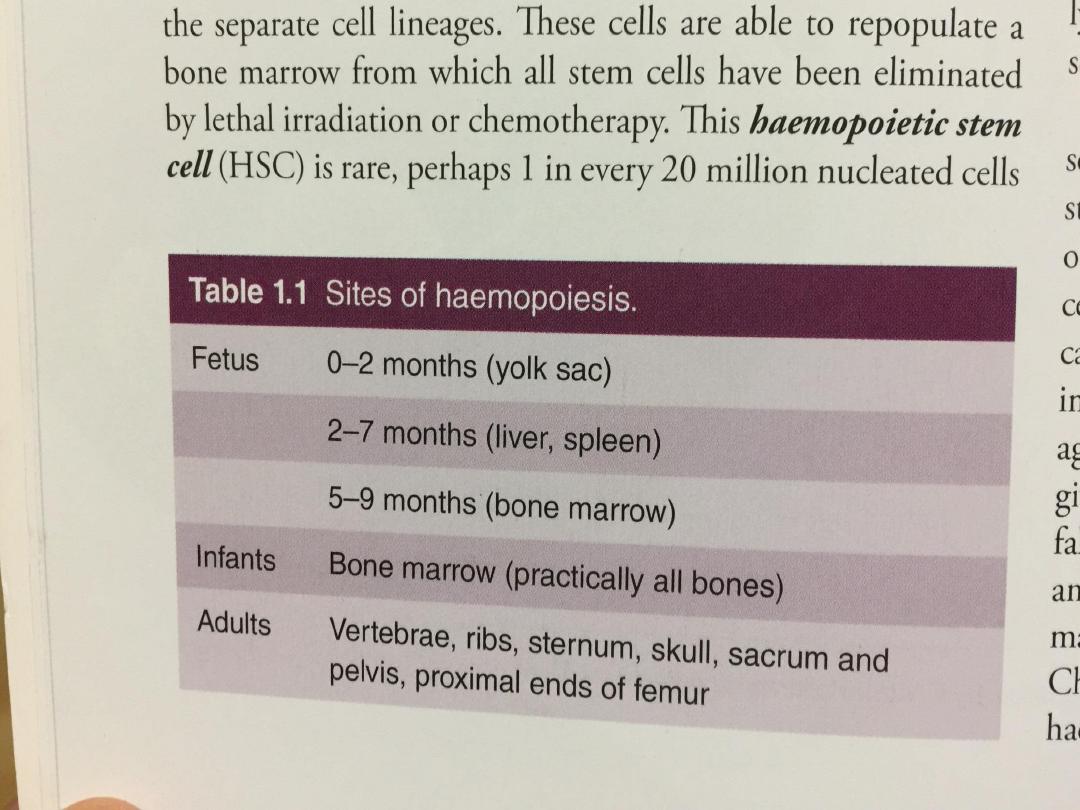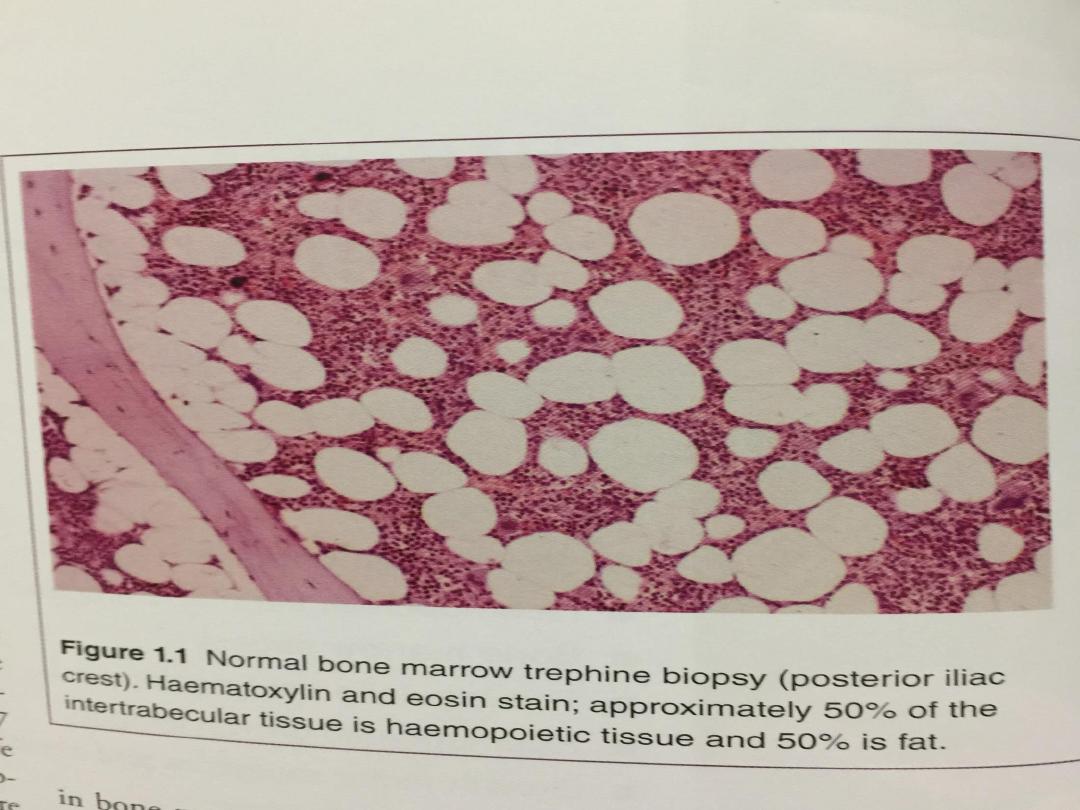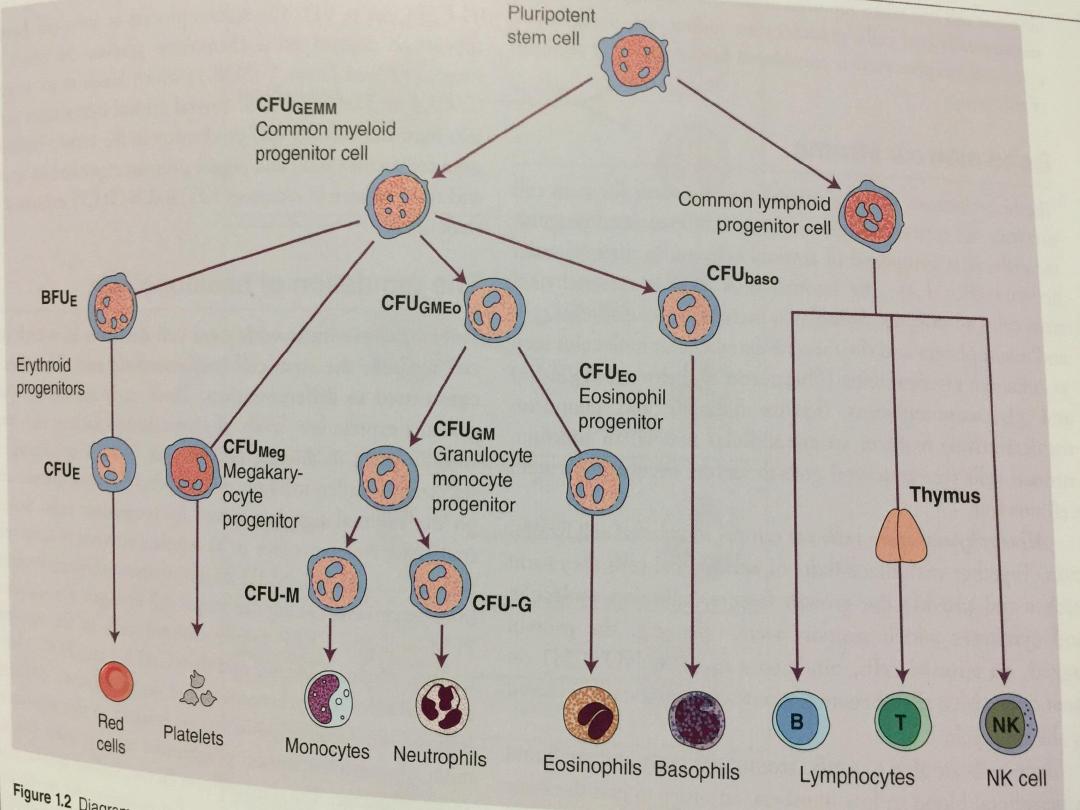
Hematopoiesis:
• Hematopoiesis is the process by which all of your
blood cells are formed, develop and mature into
their final adult types.
• beginning with what’s known as a hematopoietic
stem cell, going through a series of steps to arrive
at the final product—a mature blood cell, whether
it’s a red blood cell, a white blood cell such as a
lymphocyte, or some other type of blood cell.
• The sites of blood cell production depend on
whethaer you are talking about a baby still in its
mother’s womb, or after wards during infancy and
throughout adulthood.
1

• That is, in utero, a developing child uses a variety of
different sites in the body for hematopoiesis,
including the liver, spleen, thymus, lymph nodes, as
well as the bone marrow. After birth, the main site
of hematopoiesis is the
• Extramedullary hematopoiesis is the formation of
blood cells at sites other than the bone marrow.
And while extramedullary hematopoiesis is the
norm for a baby in the womb, once a person is
born, it is generally a sign of disease, or an
indication that the bone marrow is unable to
produce enough healthy red blood cells to meet the
demand.
2

3

• Hematopoietic
stem cell transplantation
, also called
bone marrow transplant or stem cell transplant,
involves taking donated stem cells and giving them
to a recipient, so that the recipient can make his or
her own new red blood cells, white blood cells, and
platelets.
• Hematopoietic malignancy refers to cancer of the
blood-forming cells. Hematopoietic malignancies
include leukemia, lymphoma and myeloma
• Circulating blood contains a mix of cells, cell
products, and fluids. Our bodies produce blood cells
continuously from the time we are in the womb up
to to old age. Millions of blood cells are replaced
each day as they live out their lifespans.
4

5

• Different types of cells have different life spans, and
in healthy adults, red blood cells normally live
about 100 to 120 days before they need to be
replaced.
• Blood-forming cells make for two different sides of
the family tree:
• The lymphoid side is easier to remember because it
gives rise to the white blood cells known
as lymphocytes. Lymphocytes can be further
classified as T cells, B cells and natural killer cells.
• The myeloid side of the family
• You have your red blood cells, which are also
called erythrocytes, as well as your blood platelets,
which are basically called megakaryocytes.
6

• But then, in addition to your red blood cells and
platelets, you also have all of the white blood cells that
come from myeloid progenitors: neutrophils,
monocytes, eosinophils and basophils are all white
blood cells that come from the myeloid progenitors.
• White blood cells (leukocytes): These include
lymphocytes, monocytes and polymorphonuclear
white cells that provide our bodies with protection
from infection. Problems with white blood cells can
lead to infection.
• Red blood cells (erythrocytes): These cells contain the
hemoglobin that gives your blood its red color and
carries oxygen to the cells and tissues in your body.
Deficiency of red blood cells can lead to anemia, with
symptoms such as fatigue, weakness and intolerance to
exercise.
7

• Platelets: Megakaryocytes in the bone marrow are
the "monster" cells (they are large compared to
others) that produce (platelets) that help control
bleeding after injury. Platelet deficiencies can lead to
easy bruising and trouble with bleeding.
8

9

• Hematopoietic Cell Transplantation - Bone Marrow
Transplants
• The treatment of leukemia, lymphoma and other
blood cancers may involve a transplant of
hematopoietic stem cells. These can be your own
cells, harvested from your bone marrow
(autologous), or from a donor (allogenic).
• Extramedullary Hematopoiesis : This is the term
used for blood cell production that occurs outside
of the bone marrow. It can be seen in chronic
anemia, with production of blood cells in the liver,
spleen and sometimes in the lymph nodes.
10

• The number of leukocytes in the blood is often an
, and thus the WBC count is an
important subset of the
. The
9
/L
and 11 × 10
9
/L.
• An increase in the number of leukocytes over the upper
limits is called leukocytosis. It is normal when it is part
of healthy immune responses, which happen
frequently. It is occasionally abnormal, when it
is neoplastic or autoimmune in origin. A decrease
below the lower limit is called leukopenia. It weakens
the immune system.
• All white blood cells are nucleated, which distinguishes
them from the anucleated red blood cells and platelets.
Two pairs of broadest categories classify them either by
structure (granulocytes or agranulocytes) or by cell
lineage (myeloid cells or lymphoid cells).
11

• These broadest categories can be further divided
into the five main
types:
, and
• These types are distinguished by their physical and
functional characteristics. Monocytes and
neutrophils are phagocytic.
12

Neutrophil
• Neutrophils are the most abundant white blood
cell, constituting 60-70% of the circulating
leukocytes.
They defend
against
infection.
• They are commonly referred to as
polymorphonuclear (PMN) leukocytes, although, in
the technical sense, PMN refers to all granulocytes.
• They have a multi-lobed nucleus, which consists of
three to five lobes connected by slender
strands.This gives the neutrophils the appearance of
having multiple nuclei, hence the name
polymorphonuclear leukocyte.
13

• Neutrophils are active in phagocytosing bacteria
and are present in large amount in the pus of
wounds. Neutrophils are the most common cell
type seen in the early stages of acute inflammation.
The life span of a circulating human neutrophil is
about 5.4 days
14

Eosinophil
• Eosinophils compose about 2-4% of the WBC total.
This count fluctuates throughout the day,
seasonally, and during
. It rises in
response to allergies, parasitic infections, collagen
diseases, and disease of the spleen and central
nervous system.
• The most important causes of eosinophilia include
allergies such as asthma, hay fever, and hives; and
also parasitic infections.
15

Basophil
• Basophils are chiefly responsible
for
chemical
causing the
. Because they are the rarest of the white
blood cells (less than 0.5% of the total count)
• They excrete two chemicals that aid in the body's
defenses: histamine and heparin. Histamine is
responsible for widening blood vessels and
increasing the flow of blood to injured tissue.
• Heparin is an anticoagulant that inhibits blood
clotting and promotes the movement of white
blood cells into an area.
16

Lymphocyte
• Lymphocytes are much more common in the
lymphatic system than in blood. Lymphocytes
include:
•
T cells:
• CD4+ helper T cells:
• CD8+ cytotoxic T cells:
• Natural killer cells .
17

Monocyte
• Monocytes, the largest type of WBCs, share the
"vacuum cleaner" (
) function of
neutrophils, but are much longer lived.
• Monocytes eventually leave the bloodstream and
become tissue macrophages, which remove dead
cell debris as well as attack microorganisms.
• Mast cells
• Dendritic cells
• Histiocytes
18

Disorders
• The two commonly used categories of white blood
cell disorders divide them
into those
causing excessive numbers (
disorders)
and those causing insufficient numbers
(
).
• WBC proliferative disorders can be classed
as myeloproliferative and lymphoproliferative.
Some are autoimmune, but many are neoplastic.
• Another way to categorize disorders of white blood
cells is qualitatively. There are various disorders in
which the number of white blood cells is normal but
the cells do not function normally
19

Leucopenias
• This type of white blood cell decreased is usually
the neutrophil. In this case the decrease may be
called
. Less commonly, a decrease in
lymphopenia) may be seen.
Neutropenia
• Neutropenia can be acquired or intrinsic. A
decrease in levels of neutrophils on lab tests is due
to either decreased production of neutrophils or
increased removal from the blood.
20

, sulfas or
, benzenes
• Intrinsic disorders - Fanconi's, cyclic
neutropenia, Chédiak–Higashi
• Immune dysfunction AIDS, rheumatoid arthritis
• Blood cell dysfunction - megaloblastic
anemia, myelodysplasia, marrow failure,
acute leukemia
• Any major infection
• Miscellaneous - starvation, hypersplenism
21

Lymphocytopenia
• Like neutropenia, lymphocytopenia may be
acquired or intrinsic and there are many causes.
• Inherited immune deficiency - severe combined
immunodeficiency, common variable immune
deficiency, ataxia-telangiectasia, Wiskott-Aldrich
syndrome,,
• Blood cell dysfunction - aplastic anemia
• Medications – chemotherapy
• Radiation
• Major surgery
• Miscellaneous kidney or bone marrow transplant,
22

•
Nutritional/Dietary -
23

• An increase in the number of white blood cells
in
is called
• This increase is most commonly caused
by
• There are four major causes: increase of production
in bone marrow, increased release from storage in
bone marrow, decreased attachment to veins and
arteries, decreased uptake by tissues.
• Leukocytosis may affect one or more cell lines and
can be neutrophilic, eosinophilic, basophilic,
monocytosis, or lymphocytosis.
24

Neutrophilia
• Neutrophilia is an increase in the absolute
neutrophil count in the
. Most
cases of neutrophilia are secondary to
inflammation
Primary causes
• Conditions with normally functioning neutrophils –
hereditary neutrophilia, Pelger–Huet anomaly
• Leukemia (chronic myelogenous (CML)) and
other myeloproliferative disorders
• Surgical removal of spleen
25

Secondary causes
• Chronic
– especially
), and
chronic
•
– occurs in 25–50% of chronic
smokers and can last up to 5 years after quitting
• Stress – exercise, surgery, general stress
• Medication induced – corticosteroids
• Cancer
26

Eosinophilia
• Eosinophil counts are higher in newborns and vary
with age, exercise, environment, and exposure to
allergens. Eosinophilia is never a normal lab finding.
Lymphocytosis
• is a feature of infection, particularly in children. In
the elderly, lymphoproliferative disorders,
including chronic lymphocytic
leukaemia and lymphomas, often present
with lymphadenopathy and a lymphocytosis.
27

Causes of absolute lymphocytosis include:
• acute
as
infections, such as
• chronic intracellular bacterial infections such
as tuberculosisor brucellosis
• chronic lymphocytic leukemia
• acute lymphoblastic leukemia
28
